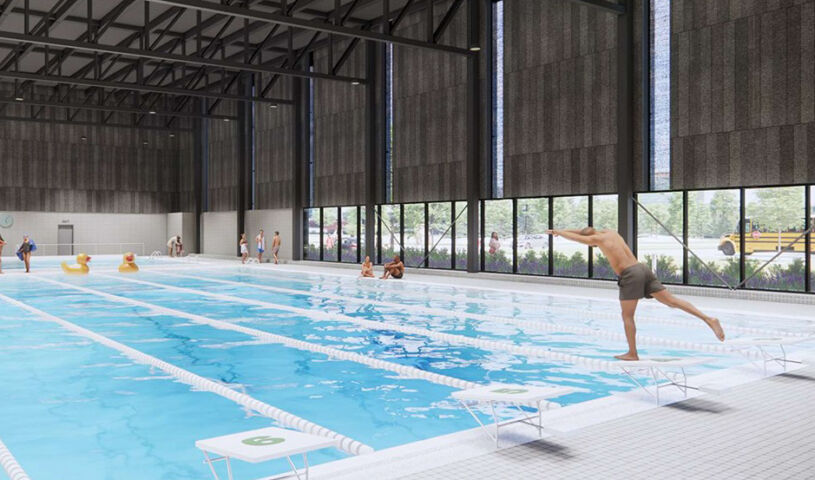Ontario aquatics calls for greater swimming infrastructure investment
 Aquatic Sport Council of Ontario has introduced a white paper advocating for a dedicated provincial fund and intake process for new swimming infrastructure. Photo: Town of Whitby
Aquatic Sport Council of Ontario has introduced a white paper advocating for a dedicated provincial fund and intake process for new swimming infrastructure. Photo: Town of Whitby
Brian Miess has spent 16 years as an aquatic director in the municipal space. As such, he knows full well how difficult it can be for municipalities to invest in aquatics infrastructure.
Miess, who is CEO at Lifesaving Society Ontario, is also a spokesperson for Aquatic Sport Council of Ontario (ASC). The aquatic council represents Ontario Water Polo, Swim Ontario, Ontario Artistic Swimming, Lifesaving Society, Parks and Recreation Ontario, and Dive Ontario.
Miess is wholeheartedly backing the ASC’s call for greater provincial, municipal, and industry stakeholder investment in Ontario’s future sport and community infrastructure.
On Jan. 27, ASC introduced “Building More Aquatic Centres in Ontario,” a white paper advocating for a dedicated provincial fund and intake process. This initiative allows municipalities and provincial sport organizations to apply for funds to build diversified aquatic facilities with 50-metre pools, promoting significant regional sport infrastructure.
“The lack of funding for municipal aquatic centres across the province continues. Municipalities continue to struggle with how to meet the demand and how to find the revenue,” Miess said. “We’re asking the provincial government to look at the need and start to put that type of infrastructure money in place, but with some guidelines, too.”
Support for Aquatic Infrastructure
The ASC is a leading voice for aquatic sports across Ontario, supporting the advancement and design of aquatic sport infrastructure. That mandate has driven the aquatic council to craft this call for greater municipal support.
The ASC states that Ontario does not have enough pools to support its growing population. Besides, most municipal governments are not resourced to fund regionally significant sport infrastructure.
Many Ontario communities lack equitable access to the benefits of pools. Municipal recreation departments need provincial support for planning and development.
“There is an unequal distribution of pools across communities, leaving many Ontarians underserved,” said ASC chair Anne Bell. “Our white paper provides actionable recommendations that will help the province provide equitable pool access for generations to come so that we can inspire the next generation of athletes while increasing access to water-based programming.”
Focus Made of 50-Metre Pools
Miess estimates there are thousands of small, community-based recreation facilities around the province. It’s more likely, he adds, that a city alone with the support of existing infrastructure programs can find ways to build a $10-million pool.
Those pools are good for running one program at a time, in most cases. But there are limitations with such facilities. Miess said it would be great if municipalities had larger facilities that not only housed a swimming pool, but also included other assets such as gymnasiums, sports fields, or other services.
This is why ASC is searching for a way to start putting money toward the larger, 50-metre facilities. That said, the construction of such facilities would have to be controlled in terms of location.
“We don’t need three, 50-metre pools within 50 kilometres of each other,” Miess said, adding that the process to determine potential locations is nearly as important as providing the funding itself.
That said, Miess said capital money comes from only two resources at the end of the day: the residential tax base or the business tax base.
“I think they’re not (building these facilities) because they just don’t have the money in the capital budget. It just comes down dollars and cents – 100 per cent,” Miess said. “They’re delayed because the capital funds need to go to a higher priority – roads, sewers, the basic infrastructure requirements to keep the city floating. And taxpayers don’t want to see massive tax increases.”
Whitby as an Example
The reality of the situation is one that John Romano understands well. Romano, commissioner of community services at the Town of Whitby, said he believes the white paper “makes a lot of sense.”
Romano said most municipalities in Ontario face challenges when it comes to funding. Whether it’s pools, garbage collection, or snow plowing, there’s never enough money.
In Whitby, Romano said, work is continuing on a 10-lane, 25-metre pool. The cost on that build is around $1,100 per square foot. And by comparison, the rest of the complex is upward of $700 per square foot.
These costs are on a 25-metre facility. If the municipality was to add another 25 metres to the pool, the facility could reach around 35,000 square feet. As a result, the price tag would close to double the earlier estimate.
“It’s going to prevent the construction of something else or the delivery of some other service,” Romano said. “So, the idea of having a provincial fund available that encourages municipalities and other non-profits or private sector partnerships that would get funding to build these types of amenities – it makes a tremendous amount of sense from my perspective.”
Demand Growing for Aquatics
Aquatics programming is growing in many communities. This includes everything from learn-to-swim initiatives for children to aqua-fit programs for seniors.
Looking again at Whitby as an example of that demand, Romano points to the community’s recently completed recreation master plan. Whitby surveyed some 4,700 people in the creation of its master plan and 62 per cent said they participated in swimming. Eighty-five per cent said they would support prioritizing swimming infrastructure.
Those numbers, Romano said, are “pretty powerful” in terms of the value that the public places on aquatics.
“The community places a high value on this type of infrastructure,” Romano said. “It is part of the fabric or what could be the fabric of a strong community, and it’s important to residents. There’s no question about that.”
Look Ahead to the Future
Both Miess and Romano agree the white paper’s case for a provincially supported funding model speaks for itself. But at a time when both provincial and municipal dollars are so tight, what are the odds the ASC’s proposal will be taken seriously?
Miess said he believes “hopes are high,” given the aquatic council’s belief that the province is paying attention to their call.
“They recognize that the research is there,” Miess said. What is needed next, he added, is for the municipal sector to agree that while small community pools are great, there would be an even bigger win if more geographically focused, multi-purpose facilities anchored by a 50-metre aquatic facility could be a financially viable option.
“That’s the business case side of it, and I think that’s the shortfall at the end of the day,” Miess said. “Most people are educated enough to understand the importance of this. It just comes down to the almighty dollar at the end of the day.”
Making the Case for Funding
Romano said he believes the recommendations in the white paper speak for themselves. It’s clear, he said, that a 50-metre pool is a regional asset. And it’s also clear that it is “very, very difficult” for a single municipality to take on such a project.
Anyone considering local priorities and the need for a larger regional facility, Romano said, would undoubtedly agree with the white paper’s recommendations. But also, the reality is that statistics show these types of larger facilities currently aren’t getting built.
“Municipalities aren’t doing it. They can’t afford it for whatever the reasons are,” Romano said. “If we’re going to have these types of facilities … which is something that’s important to Canadians – to Ontarians – I think those things come together to make this document hard to just ignore.” MW
✯ Municipal World Executive and Essentials Plus Members: You might also be interested in Diane English’s article: Supporting healthy, resilient communities.
Sean Meyer is digital content editor for Municipal World.
Related resource materials:
- Canadians, get your Crokicurl on!
- Canadian City Parks Report: Report shows data gap around changing park use
- Surrey, Mississauga latest cities to launch e-bike programs


